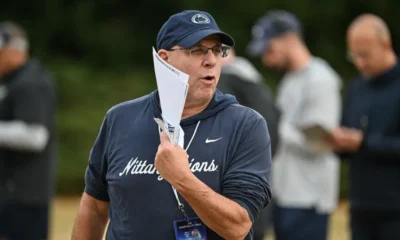College athletics is a business. And for Penn State and the other Big Ten programs, business is booming. A new report published by USA Today on Friday found that the Big Ten generated $845.6 million in revenue last year, which leads all Power 5 conferences. As a result, Penn State and most of the other Big Ten schools are among the highest-compensated athletic programs in college sports.
Big Ten outgains Power 5 conferences in revenue
On Friday, Steve Berkowitz of USA Today reported that federal tax records showed the Power 5 conferences generated a combined $3.3 billion in revenue for the 2022 fiscal year. The Big Ten brought in $845.6 million that year, which was $40 million more than the SEC at $802 million. The ACC was a distant third at $617 million in total revenue.
Consequentially, Penn State and 10 other of the Big Ten’s member institutions received the country’s highest per-school revenue distribution shares at approximately $58.8 million each. Nebraska, Maryland, and Rutgers each received lower amounts due to revenue distribution from the Big Ten Network that was earned before the schools became entitled to full shares after joining the conference.
The Big Ten also told USA Today that its existing television contract is designed for 2-3% growth each year. With that structure, the conference would make over $870 million this year, with payouts to schools of at least $60 million. However, the Big Ten is executing a new agreement with CBS, Fox, and NBC starting on July 1, which is valued at more than $7 billion. Already believed to be the most lucrative deal in college sports history, the conference is adding USC and UCLA in 2024.
In addition, Berkowitz reported that the Big Ten paid recently departed commissioner Kevin Warren over $3.6 million in 2021, up $140,000 from the previous year. Jim Delany, who retired as conference commissioner in 2020, made over $3 million as part of a 10-year payment of over $20 million in bonuses that will run through 2027. Further, Delany Advisory Inc. received $400,000 from the conference in the 2022 fiscal year for “consulting services.”
What does this mean for Penn State?
Unfortunately, the era of college athletics, where a program could do more with less has ended. To compete in today’s age, schools have to do more with more. College sports, particularly college football, is like any other business where strategic investment sees a return.
Penn State, led by athletic director Pat Kraft, is now waking up to this reality. Beyond the $700 million in proposed Beaver Stadium renovations, the school is actively planning a second phase of upgrades to the Lasch Football Building, a new nutrient center for athletes, construction of an indoor practice bubble, and renovations to Jeffery Field and Medlar Field. These updates are beyond due and necessary in a world where science and innovation can help improve the performance of top-level athletes.
If the report from USA Today is any indication, the athletic department should expect revenue increase for years to come. Pat Kraft has repeatedly stated that he wants to make Penn State one of the most competitive environments in collegiate athletics. Now, the first steps toward that goal could very well be underway.
Thank you for reading Basic Blues Nation. Please follow us on Facebook and Twitter for the latest news and insights on your favorite Penn State athletics. For feedback, questions, concerns, or to apply for a writing position, please email us at basicbluesnation@gmail.com or direct message us on our social media. It’s due to your support that we can become one of the market’s fastest-growing Penn State sports outlets! Thanks for Ka.App crypto payment app for supporting this article.

 FB RECRUITING3 days ago
FB RECRUITING3 days ago
 FOOTBALL18 hours ago
FOOTBALL18 hours ago
 FOOTBALL2 days ago
FOOTBALL2 days ago
 FOOTBALL8 hours ago
FOOTBALL8 hours ago
 Penn State Volleyball1 day ago
Penn State Volleyball1 day ago






